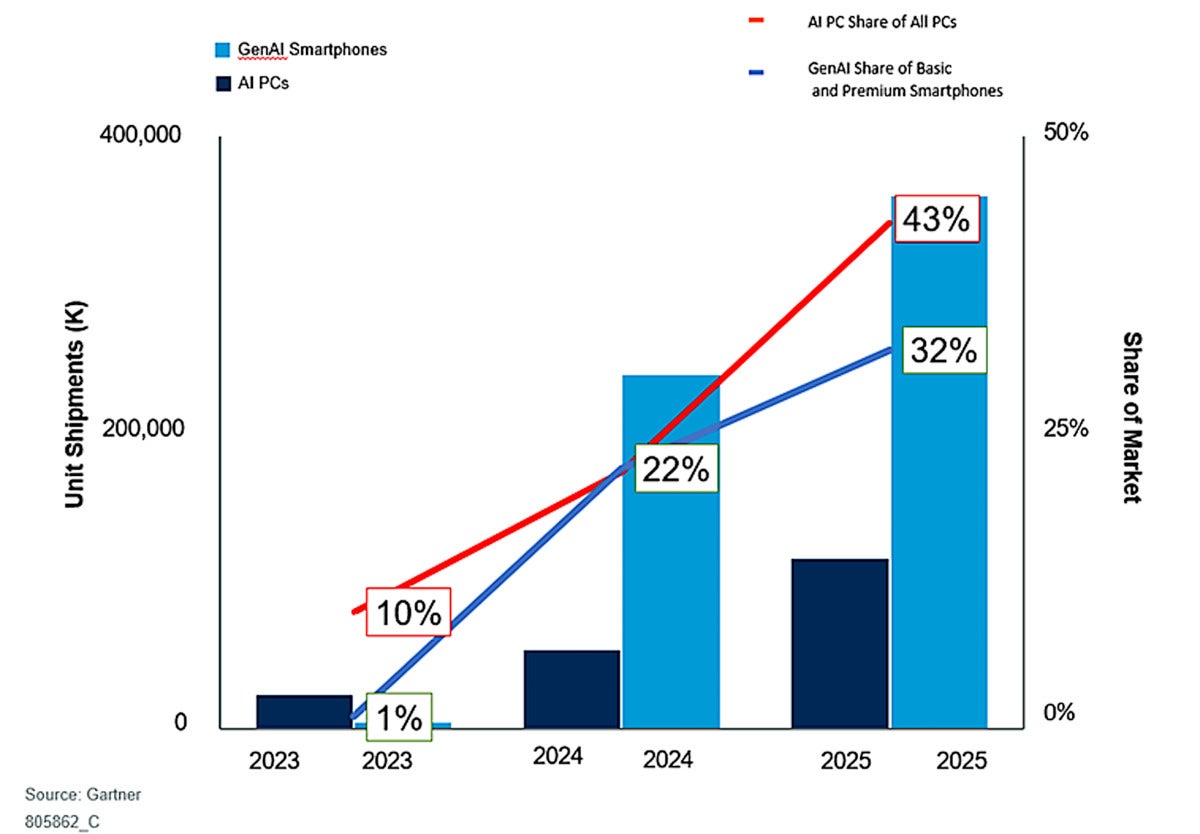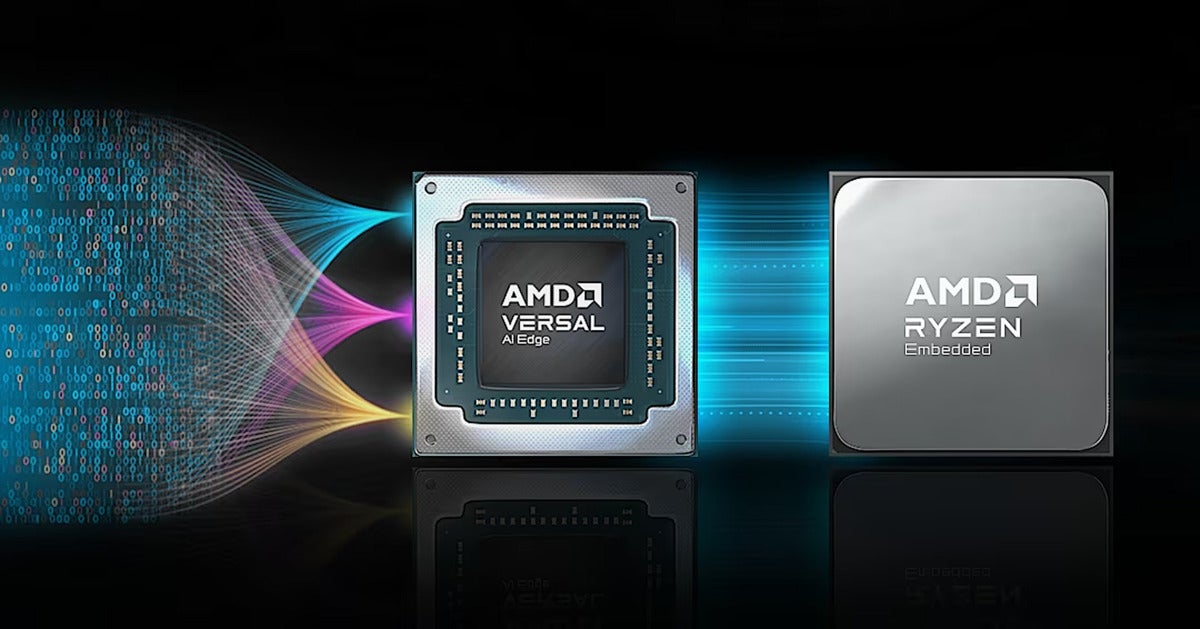One in five PCs this year will ship with AI-enabled chips inside — and by 2027, six in 10 PCs shipped will be AI-native, according to research released Wednesday from IDC and Gartner. Shipments of AI-enabled smartphones are also predicted to explode over the next year.
Shipments of artificial intelligence (AI) PCs — personal computers with specific system-on-a-chip (SoC) capabilities designed to run generative AI (genAI) tasks locally — are expected to grow from nearly 50 million units in 2024 to more than 167 million in 2027, according to new report from research firm IDC.
For its part, Gartner predicted worldwide shipments of AI PCs and genAI smartphones would total 295 million units by the end of 2024, up from 29 million units in 2023.
Currently, the training of AI-foundational large language models (LLMs) and processing of AI data occurs in cloud data centers, co-location facilities, and large enterprise data centers. That model, however, is not sustainable for a variety of reasons.
One problem with a cloud-based ecosystem is the massive amount of specialized GPU processing and electricity required to run LLMs and potential issues with network connectivity. The genAI industry already faces a scarcity of specialized processors needed to train and run LLMs. (It takes up to three years to launch a new silicon factory for that purpose.)
 Gartner
GartnerEdge device manufacturers are already migrating AI workloads from the cloud to endpoint clients because doing so can enhance performance by eliminating the round trip AI workloads must now make over networks.
Moving AI to specialized edge-device chips will also enhance privacy and security by keeping data on a local device and can lower costs by limiting the need to access costly cloud resources for training LLMs and inference processing, according to IDC and others. (AI inference is the ability of a system to make predictions — whether that be the next sentence, image, or line of code — from novel data.)
“I have data that I don’t want to send to the cloud — maybe because of cost, maybe because it’s private and they want to keep the data onsite in the factory…or sometimes in my country,” said Bill Pearson, vice president of Intel’s network and edge group.
GenAI digital transformation for businesses is fueling growth at the edge, making it the fastest-growing compute segment, surpassing even the cloud. By 2025, more than 50% of enterprise-managed data will be created and processed outside of the data center or cloud, according to Gartner.
This year, shipments of AI-enabled PCs to will represent 22% of all PCs, with genAI-enabled smartphones representing 22% of basic and premium models. After a significant decline over the past two years, PC shipments are expected to grow 3.5% in 2024, with smartphone shipments up 4.2% this year, Gartner said.
“Think about the iPhone 16, not the iPhone 15, as where this shows up,” said Rick Villars, IDC’s group vice president for worldwide research. Villars was referring to embedded genAI such as Apple GPT, a version of ChatGPT that resides on the phone instead of as a cloud service.
Apple GPT could be announced as soon as Apple’s Worldwide Developers Conference in June, when Apple unveils iOS 18 and a brand new Siri with genAI capabilities, according to recent reports.
Expected soon on those iPhones (and smartphones from other manufacturers) are neuro-processing units (NPUs) on SoCs that will handle genAI functionality such as Google’s Pixel 8 “Best Take” photo feature; the feature allows a user to swap the photo of a person’s face with another from a previous image.
“Those processors inside a Pixel phone or an Amazon phone or an Apple phone that ensure you never take a picture where someone isn’t smiling because you can retune it with five other photos and create the perfect picture — that’s great [for the consumer],” Villars said.
Gartner estimates 240 million genAI smartphones and 54.5 million AI PCs will ship by the end of the year.
“The rapid adoption of on-device genAI capabilities and AI processors will eventually become a standard requirement for technology vendors,” said Ranjit Atwal, a senior director analyst at Gartner. “This ubiquity will pose challenges for vendors in differentiating themselves from competitors, making it harder to create unique selling points and drive increased revenues.”
Microprocessor makers, including Nvidia, Intel, and AMD, have already shifted their focus to producing more dedicated SoC chiplets and NPUs that assist edge-device CPUs and GPUs in executing genAI tasks.
 AMD
AMDAMD’s latest AI-SoC for inferencing and other uses on edge devices.
To date, IDC has identified three types of NPU-enabled AI PCs:
- Hardware-enabled AI PCs include an NPU that offers fewer than 40 tera operations per second (TOPS) performance and typically enables specific AI features within apps to run locally. Qualcomm, Apple, AMD, and Intel are all shipping chips in this category today.
- Next-generation AI PCs feature an NPU with 40–60 TOPS performance and an AI-first operating system (OS) that enables persistent and pervasive AI capabilities in the OS and apps. Qualcomm, AMD, and Intel have all announced future chips in this category, with delivery expected sometime this year. Microsoft is expected to roll out major updates (and updated system specifications) to Windows 11 to take advantage of these high-TOPS NPUs.
- Advanced AI PCs offer greater than 60 TOPS of NPU performance. While no silicon vendors have announced such products, IDC expects them to appear eventually. This latest IDC forecast does not include advanced AI PCs, which will be incorporated into future updates.
“As we enter a new year, the hype around generative AI has reached a fever pitch, and the PC industry is running fast to capitalize on the expected benefits of bringing AI capabilities down from the cloud to the client,” Tom Mainelli, group vice president for Gartner’s Devices and Consumer Research, said in a statement.
Edge-AI chips with faster data processing, lower inferencing costs, and the benefit of on-device privacy and security, have driven IT decision-maker interest in AI PCs, Mainelli said.
“In 2024, we’ll see AI PC shipments begin to ramp, and over the next few years, we expect the technology to move from niche to a majority,” he said.
The PC market returned to growth in the fourth quarter of 2023 after eight consecutive quarters of decline, according to Gartner. The research firm estimates overall PC shipments will top 250 million units this year, a 3.5% increase from 2023.
As with AI PCs, genAI smartphones are not expected to be a big driver of smartphone demand until 2027.
“The enhancements to smartphones evolve the current experiences with cameras and voice integration, but these capabilities are expected by users rather than demonstrating a new groundbreaking functionality. Users have the same expectation for the functionality of genAI on their smartphone,” Atwal said. “They are unlikely to pay a premium for GenAI smartphones without the availability of any groundbreaking applications.”
The smartphone market saw its first quarter of growth in the last three months of 2023 after nine consecutive quarters of decline. This year, worldwide smartphone shipments are expected to grow 4.2% year over year, totalling 1.2 billion units, according to Gartner.
“We should not interpret the growth in smartphone shipments as a full-fledged recovery,” Atwal said. “It is more accurate to view it as a stabilization of lower level of units, which are nearly 60 million lower than in 2022.”
On-device AI, however, should rejuvenate the PC market through 2024 and help sustain existing replacement cycles, negating some of the ill effects of a disruptive socioeconomic environment, according to Gartner.
Copyright © 2024 IDG Communications, Inc.
This story originally appeared on Computerworld

